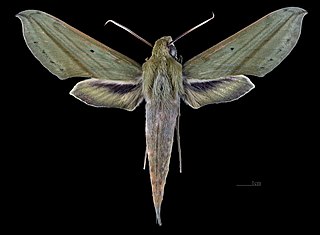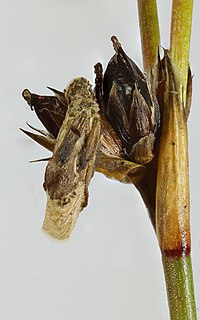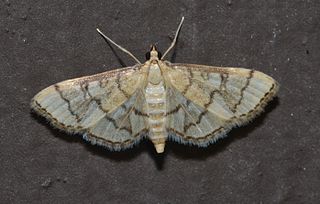
The brimstone moth is a moth of the family Geometridae. The species was first described by Carl Linnaeus in his 1758 10th edition of Systema Naturae.

The shark is a moth of the family Noctuidae.

Mycalesis oculus, the red-disc bushbrown, is a satyrine butterfly found in southern India. It is similar in markings to Mycalesis adolphei but distinguished by the reddish band around the large apical spots on the upper forewings.

The angle shades is a moth of the family Noctuidae. The species was first described by Carl Linnaeus in his 1758 10th edition of Systema Naturae. It is distributed throughout Europe as far east as the Urals and also in the Azores, in Algeria, and in Asia Minor, Armenia, and Syria. It is strongly migratory.

Prosotas nora, the common lineblue, is a species of lycaenid butterfly found in Asia to Australia.

Gangara lebadea, the banded redeye, is a species of hesperid butterfly found in Southeast Asia.

Idaea fuscovenosa, the dwarf cream wave, is a moth of the family Geometridae. It is found in the Palearctic,

Aporandria is a monotypic moth genus in the family Geometridae described by Warren in 1894. Its single species, Aporandria specularia, was first described by Achille Guenée in 1857. It is found in Sri Lanka, India, Vietnam, Thailand, the Andamans, Peninsular Malaysia, Sumatra, Borneo, the Philippines and Sulawesi.
Cissusa indiscreta, the indiscreet cissusa moth, is a species of moth in the family Erebidae. The species is found from British Columbia, south to California and in the south-west from Arizona to central Colorado. The habitat consists of oak woodlands and mixed hardwood forests.

Xylophanes elara is a moth of the family Sphingidae first described by Herbert Druce in 1878. It is known from Paraguay, Suriname, Venezuela, Bolivia and Brazil.

Xylophanes libya, the Libya sphinx, is a moth of the family Sphingidae. The species was first described by Herbert Druce in 1878. It is known from southern Texas, Mexico, Belize, Guatemala, Panama and from Venezuela south and west to Bolivia and Paraguay.
Prochoreutis extrincicella is a moth of the family Choreutidae. It is found in the United States, including Illinois, Maryland and Kentucky.

Coleophora taeniipennella is a moth of the family Coleophoridae. It is found in most of Europe.

Protorthodes melanopis is a moth in the family Noctuidae. It is found across the southern United States, from western Texas to southern California. Its range extends as far north as southern Utah and as far south as northern Mexico.

Protorthodes texicana is a moth in the family Noctuidae first described by J. Donald Lafontaine in 2014. It is known from west-central Texas and southern Mexico.

Blepharomastix ranalis, the hollow-spotted blepharomastix moth, is a species of grass moth of the family Crambidae found in the eastern and southern United States and Mexico.
Udea alaskalis is a moth in the family family Crambidae. It was described by Arthur Gibson in 1920. It is a high Arctic species found in North America, where it has been recorded from Alaska. It is also found in Greenland and northern European Russia.

Papilio rumiko is a species of swallowtail butterfly. It is found from the south-western United States, through Mexico, El Salvador, Honduras, Costa Rica to Panama. The northernmost record is north-eastern Colorado.
Prolita puertella is a moth of the family Gelechiidae. It was described by August Busck in 1916. It is found in North America, where it has been recorded from Montana, California and Arizona. It has also been reported from Baja California.

Teliphasa erythrina is a species of moth of the family Pyralidae. It is found in China (Yunnan).


















